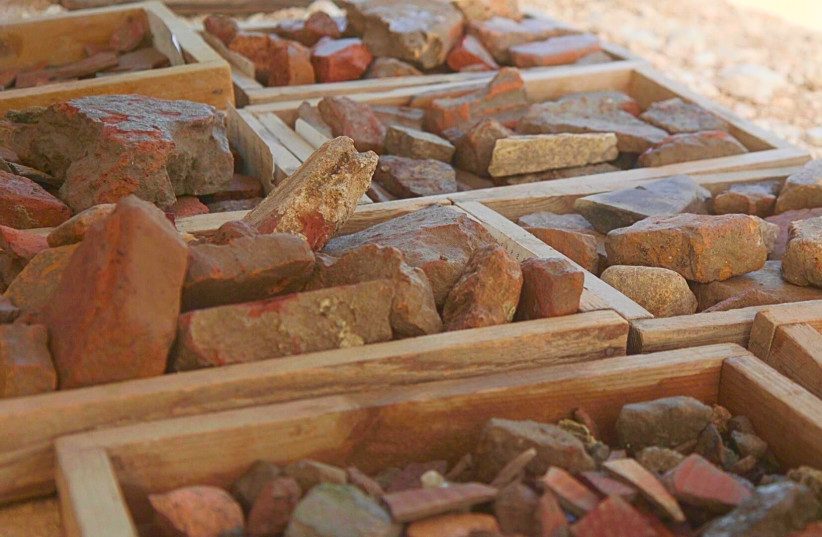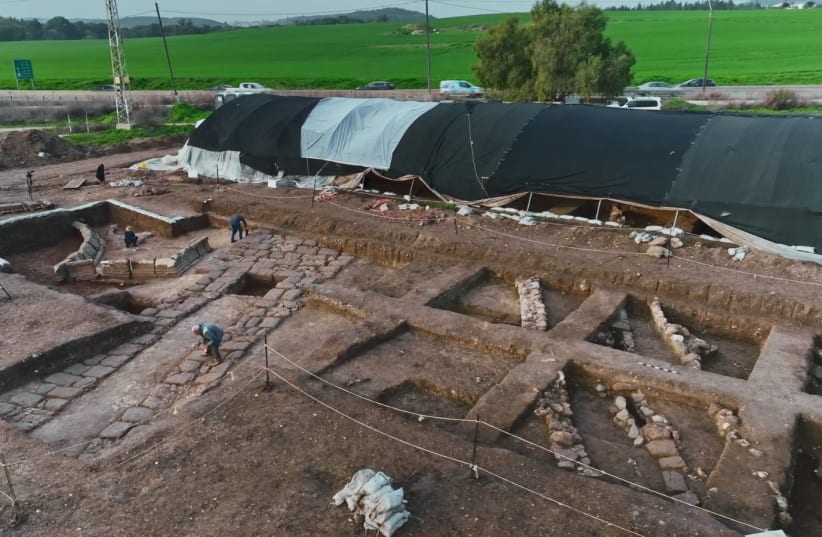1,800-year-old Roman Legionary Base discovered at Tel Megiddo
The VIth Legion Roman legionary base is the only Roman military base of these dimensions that has been located and exposed in Israel.
The excavation was funded by the Netivei Israel National Infrastructure Company, said the IAA, which called it “a unique opportunity to uncover part of the full-scale Roman legionary base.”
Directed by Dr. Yotam Tepper and Barak Tzin, the dig is part of the major infrastructure project to expand and upgrade Road 66 from the Megiddo Junction to the Hatishbi Junction at Yokneam. In the course of the excavation, extensive and impressive architectural remains of the Via Pretoria (the main road of the camp) were uncovered, as well as a semicircular-shaped podium and stone-paved areas that were part of a large, monumental public building.

The VIth Legion Roman legionary base is the only Roman military base of these dimensions that has been located and exposed in the Land of Israel.
The IAA archaeologists knew about the location of the military base in 2015, when a surface excavation was carried out by the W.F. Albright Institute of Archaeological Research with support from the IAA as part of the Jezreel Valley Regional Project. But thanks to the road construction now, the ability to carry out a deep excavation was possible. Tepper stressed that the discovery of the legionary base was not accidental, as over the last decade, surveys and six seasons of archaeological excavations have been carried out within a joint academic geographical-historical research project he directed with Dr. Matthew Adams as part of the Jezreel Valley Research Project (JVRP).
“The Roman Legion camp at Legio was the permanent military base for over 5,000 Roman soldiers for more than 180 years, from 117-120 BCE to about 300 CE,” said Tepper. “Two main roads intersected at the center of the 550-meter- long and 350-m-wide camp, and its headquarters were erected here. It was from this base point that all the distances along the Roman Imperial roads to the main cities in the north of the country were measured and marked with milestones. The ancient building remains were not preserved to a height, as most of the building stones were removed over the years for reuse in building projects carried out during the Byzantine and Early Islamic periods.”
“In the course of the excavation seasons, the upper part of the commanders’ courtyard (principia) was exposed southwest of Road No. 66, and in the present excavation, carried out on behalf of the IAA. We are uncovering the northeastern part of the camp that extends alongside Road No. 66.”
Historical sources and some partial information point to the existence of a permanent Roman legionary base of the Xth Fratensis Legion in Jerusalem, but the camp still had to be discovered.
Coins, parts of weapons, pottery sherds, and glass fragments were uncovered, but the most predominant finds are the roof tiles that were found in extremely large quantities. “The roof tiles, some of which were stamped with the VIth Legion stamps, were used for various purposes, for roofing buildings, paving floors, and even coating walls. The technology and know-how, the building techniques, and the weapons that the Legion brought with it from the home country, are unique to the Roman army, reflecting specific Roman Imperial military footprints,” the IAA said.
Engineer Dima Pritsker, director of the northern branch of the Engineering and Development Unit in the Netivei Israel Company: “We are talking about an extremely important road project 15 kilometers long for reducing traffic congestion along the road and to improve the safety of drivers and passengers. The project incorporates the construction of the Megiddo Interchange at the junction of Roads 65 and 66. The Transport Ministry is investing 1.5 billion shekels in the project carried out by Netivei Israel.
IAA director-general Eli Escuzido added that “the proximity of the Roman legionary base to the National Park of Megiddo, recognized as a World Heritage Site and also to one of the earliest Christian prayer halls known in the world that we had within the Megiddo Prison compound provide the potential to enhance the tourist experience at this central location at the gateway into the Galilee. Thanks to the excavations and the concentration of well-preserved archaeological remains, all those involved will evaluate the conservation of the site and the future of the planned Road No. 66.”


No comments:
Post a Comment
Stick to the subject, NO religion, or Party politics